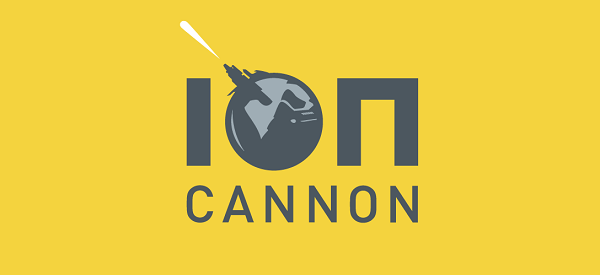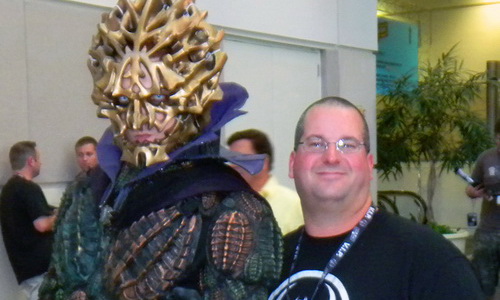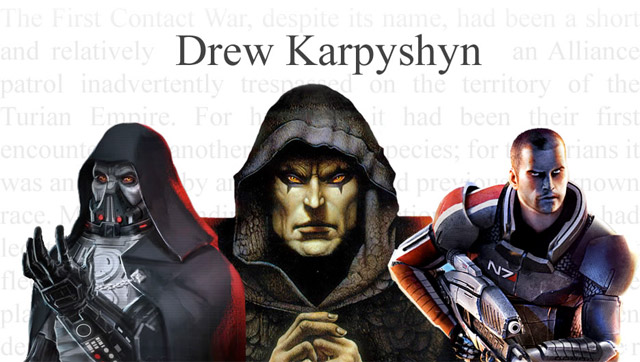The Star Wars Report and Star Wars Beyond the Films are proud to present to you, our recent interview with New York Times Best Selling Author; Drew Karpyshyn. Drew’s known for his work with Bio-Ware on the Star Wars Knights of the Old Republic, as well as The Old Republic, games, and also notably his additions to the EU with the Darth Bane Trilogy and most recently The Old Republic: Revan and Annihilation. Beyond the Films was able to catch up with Drew and ask him a few questions about his recent work. So, with all that said, please enjoy!
First, Mr. Karpyshyn, on behalf of both hosts of Star Wars Beyond the Films (Mark Hurliman and Nathan P. Butler), thank you for your time and congratulations on another outstanding Star Wars novel. Annihilation is a heck of a thrill ride for The Old Republic fans.
Our questions:
1. Annihilation focuses on Theron Shan, a character last seen in Dark Horse Comics’ The Old Republic: The Lost Suns comic series. Why was Theron chosen as the lead for this story?
DK- In the past, most of my characters were powerful Jedi or Sith, so I thought it would be interesting to focus on a non-Force using character for this story; I wanted to show how an otherwise “ordinary” person could still be a hero who influences galactic events.
2. With regard to the family dynamic (or lack thereof in a practical sense as the story begins) between Theron, Jace, and Satele, the character who seems to bear the bulk of the blame (and vilification, perhaps) in their circumstances tends to be Satele. Was this intentional, or simply the byproduct of readers becoming attached to Theron and Jace and being “offended” right alongside them?
DK- I never tried to portray Satele as anything other than what a Jedi should be: she puts duty and obligation to the Republic above her own wants and desires. But this kind of fanatical adherence to a very strict code is difficult for us ordinary folk to understand, so I think it’s only natural that we feel she is somehow “wrong” in how she handled things.
3. The novel refers back to certain events (such as the “death” of the Emperor, Malgus’ fate, etc.) in the class storylines of the video game. Was there a conscious effort to avoid providing further details with regard to those events? If so, was it a matter of not wishing to spoil the game plot for potential players or simply due to player input in the game making such details too variable to pin down with many specifics? (As someone who has not played the game, Mark definitely wanted to find out more.)
DK- I think I needed to strike a balance between acknowledging key events that affected the Star Wars: The Old Republic galaxy, but I didn’t want to bog the novel down with a lot of rehashing of events that many readers were already familiar with. Besides – this is Theron’s story, so the focus is on him. There is always going to be lots going on in the Star Wars universe that influences any story but isn’t necessarily a key element to that story.
4. With regard to Gnost-Dural, what made you decide to use this Jedi who was at least somewhat already known from the TOR timeline videos, his journal with the Collector’s Edition, and the like?
DK- Many fans simply knew Gnost-Dural as an archivist and historian, but we wanted to bring out the other elements of his character. From the start he was the classic “warrior-poet”, not some cloistered academic. Expanding on his character in the novel allowed us to show a side of him that had always existed in our backgrounds, but which fans hadn’t really seen yet.
5. With you writing a novel that involved Theron, Gnost-Dural, Jace Malcom, and others we have previously seen in other media, there was some fandom wariness at first as to whether these characters, that had not been given all that much depth in previous stories due to the constraints of the media in which those stories were presented, would receive their due depth in Annihilation. We (Mark and Nathan) certainly agree that the depth was given to the characters in Annihilation, and then some. When dealing with characters that are somewhat known quantities like these, who had not yet been given as much depth as a novel can provide, how do you approach providing greater depth and detail while still needing to maintain consistency with how the characters have been presented by other writers in other media?
DK- Working in a shared universe like Star Wars, you’re always balancing your own new and unique take on characters and events with existing canon. For me, I always try to learn as much as I can about the characters, then I try to build on what is already there in ways that are logical, but hopefully still interesting and even unexpected. I don’t have a strict formula or pattern I follow – I just go with what my gut tells me works.
6. The interaction between Theron and Gnost-Dual often had the feel of a Lethal Weapon pairing, whereas Theron’s solo efforts often gave him the feel of Ethan Hunt of Mission: Impossible. What, if any, sources provided inspiration or insight into how such characters might act?
DK- The overall feel of Annihilation definitely owes a debt to the spy-thriller genre, but the specific actions of various characters weren’t influenced by that in any conscious way. Theron’s actions were mostly determined by his character as established in The Lost Suns comics and by how I had developed him through the novel; Gnost-Dural was my attempt to portray a Jedi who – though he follows the rules – has a slightly different take on what it means to be a Jedi.
7. Annihilation provides some very “real” moments that ground Theron’s tale in reality. Aside from his lineage and very human reactions to what he learns, he injures his shoulder and later his calf muscle, both of which hindered him along the way. We do not see this often in Star Wars, at least not to such a realistic extent. Was this a conscious effort to separate Theron from the saga’s many Jedi protagonists, and were his physical challenges in any way drawn from personal experience?
DK- I’m not a big fan of invincible superheroes. If you don’t suffer and show vulnerability in a character, I don’t feel there is a lot of drama in their story. Overcoming trials shouldn’t be easy – you should have some setbacks and sometimes you get injured or things go off the rails. I tend to do this for all my characters, not just the non-Jedi ones. Bane suffers a brutal beating early in his training; Revan was severely injured when his starship crashed and he was overmatched by the Emperor. I think flawed and vulnerable heroes are just more interesting; it makes their victories more significant.
8. With regard to Marcus Trant: What was the deal with his on and off “thing” with Malcom’s secretary? Was this just humanizing the characters or something that might have gotten more development if the opportunity arose?
DK- Alex Freed had established Marcus as a bit of a womanizer by alluding to his previous marriages in the Lost Suns comic, so I just took that and ran with it. It was really just something I found sort of fun and interesting about him.
9. With regard to Teff’ith and Theron’s “family” connection, this is not the first time we have seen this theme pop up in Star Wars. Do you think that the “family but not family” (“family” but not biologically) dynamic is important to the message and themes of the saga?
DK- Star Wars has always walked an interesting line between the importance of biological families and friends/allies who are so close you consider them family. Of course the destiny of the Skywalker line is central to the movies, and “I am your father” is probably the most memorable line in the history of movies. However, Han Solo is a good representation of the non-biological family bonds that Star Wars emphasizes; over the course of the original movies he goes from a man who has only one close friend (Chewie) to part of a larger, very tight-knit group. Eventually this culminates in his marriage to Leia in the later novels which makes his “family” status official. So I’m really just continuing this well established tradition.
10. We are familiar with Sith double-agents and spies on both sides from The Old Republic and its Expanded Universe offshoots. Should the Sith of this timeframe have been more hesitant to take a fallen Jedi like Karrid into their ranks, especially given why she was with them in the first place? She certainly displayed the traits necessary for a double or triple agent. Also, the way she rose to power tied in well with The Lost Suns and its climactic events. Was that something that was left hanging that you decided to run with, or was it something planned further back toward when The Lost Suns itself was in production?
DK- I think the Sith would be hesitant to accept an ex-Jedi, but true Dark Lords (like Malgus) would be pretty good at sensing whether someone like Karrid was truly embracing the dark side or just going through the motions. You can’t be a master of deception and manipulation without being able to pick up someone faking it (most of the time). As for Karrid’s rise to power, that was something I came up with when I started the novels. She actually didn’t even exist as a character until well after The Lost Suns was published.
11. With regard to your writing, you have spent time on both sides of the fence when it comes to video games and their tie-in novels. You have spent time developing sagas with player choice and alternate outcomes like The Old Republic, Mass Effect, and the like. You have then written novels in those universes, using characters that cross over from those games. Does the element of player choice in the video game media make writing prose fiction that ties into events influenced by those choices more difficult? How does one accommodate for player choice when writing something that will, by definition, deal with only one version of that prose tale’s events?
DK- Player choice is an integral part of the BioWare game experience, so it’s something I learned to deal with in the games. However, in novels you often have to just go with a singular “canon” version of events in order to tell a story that makes sense. I typically try to be as vague and detail-free as possible, but sometimes you just have to pick something and go with it. A good example is the Revan novel – it couldn’t have been written without finalizing the gender and ultimate light side/dark side choice of the video game character.
12. Speaking of dealing with continuity, there was a great deal of controversy in fandom over Darth Bane: Path of Destruction when its take on the Battle of Ruusan differed (sometimes marginally, sometimes quite a bit) from the way the tale had been told five years earlier in Darko Macan’s Jedi vs. Sith. How was the decision made to alter those events, and to what extent were you given freedom to write beyond the constraints of that prior version of events?
DK- I think the so called controversy was actually blown way out of proportion. A few minor details were changed to make the flow of events work for the novel, and a small handful of fans became very vocal about the changes. However, I think it’s much more important to capture the spirit and intent of an original work than to make sure every minor detail is exactly the same. That can limit the creation of new works so severely that you sacrifice an enjoyable reader experience. It’s a difficult line to walk, but it’s something every author in Star Wars has done (sometimes on purpose, sometimes by accident). It’s just part of working in such a massive and highly detailed world, and I think most fans understand that.
Our final two questions require a bit of setup, if you will indulge us:
Finally, there has been a great deal of contradictory information with regard to when The Old Republic takes place, along with its tie-in materials. After initially being discussed on the TOR forums as between 6 and 30 ATC (3,647 – 3,623 BBY), Rob Chestney clarified that “the time in which the game begins is less than 10 years after the Treaty of Coruscant.” He further clarified that “we’ve tried to keep this a little vague, because The Old Republic doesn’t take place in a single moment in history but over a period of a few years.” This last later clarified (again) to refer to the game taking place in a span of several years: 3,643 – 3,640 BBY. As such, Sean Williams’ Fatal Alliance, set about a decade after the Treaty of Coruscant and, supposedly, “just before” the start of the game, was finally given a date recently in The Essential Reader’s Companion of circa 3,643 BBY. Annihilation, meanwhile, had its first publicly-released timeline placement dated at 3,640 BBY, also in The Essential Reader’s Companion. Annihilation, for its part, refers back to the events of The Lost Suns as just under two years prior to the novel.
This is where things get dicey. The Lost Suns was frequently referenced as being a sort of fifth storyline for the Republic in the same time frame of the video game, which fit precisely with the “almost two years ago” timeframe presented in Annihilation if the game was set in that 3,643 – 3,640 BBY” gap. The comic even referenced the SpecForces and Angral events of the game, or so it seemed. Just recently, however, The Old Republic Encyclopedia was released, in which the start of the game is unequivocally stated as being in 3,640 BBY, three years later than had been suggested previously, and presumably earlier in the very same year as Annihilation. As such, this causes The Lost Suns, if almost two years before Annihilation, to be set before the video game now by at least a year. Needless to say, this has brought even more confusion and frustration for fans with regard to the chronology of TOR and its tie-ins.
Our questions on this issue are:
13. We know that the way fans learned of dates for The Old Republic was something kept intentionally vague publicly. As someone who worked on the game and multiple tie-in novels, how specific were the dates that you were able to work with on the production side, and did they change as these tales were being developed?
DK- These are the kinds of things that get very complicated when you have multiple projects being worked on simultaneously by huge teams of people. We do our best to keep it all straight, but sometimes things get messy or mistakes are made. So I just work with the data I’m given. I honestly don’t remember off the top of my head what date I was told to use, but I believe it was a specific year and I just used that as my starting point.
14. How, if at all, were you affected by the vague (and potentially shifting) nature of the dates for TOR-related events when writing both Revan and Annihilation?
DK- Honestly, once I started working on the project I didn’t worry about the shifting dates. Those are the kinds of things I rely on editors and the continuity folk to keep track of; I prefer to focus my energy on telling a great story.
We want to thank you very much for your time and indulgence, Mr. Karpyshyn, especially given our obsessive compulsive chronological leanings. We look forward to hopefully seeing you back in the saga again. If your Darth Bane and The Old Republic novels are any indication, we’ll be in for a treat once again.
Thanks for reading this informative interview, and be sure to check out more about Drew’s recent and older works on his personal website! Just click the image below to open the site in a new window.
You can also follow Drew on Twitter @DrewKarpyshyn!
Star Wars Beyond the Films is a podcast dedicated to discussion of the Star Wars Expanded Universe (and The Clone Wars). The show features two regular hosts, Mark Hurliman (EUCast, The Star Wars Report, & Rest Thou Softly) and Nathan P. Butler (Star Wars Tales, The Star Wars Timeline Gold, and decade-long participant in Star Wars fan audio), along with a team of rotating co-hosts, including the likes of Kelly Adams (Big Shiny Robot), Riley Blanton, (The Star Wars Report), and more.
Star Wars Beyond the Films is the official Expanded Universe podcast of The Star Wars Report and part of Middle Earth Network’s Star Wars radio lineup.
Author: admin
The Star Wars Report: A Star Wars Podcasting Network and Website.


